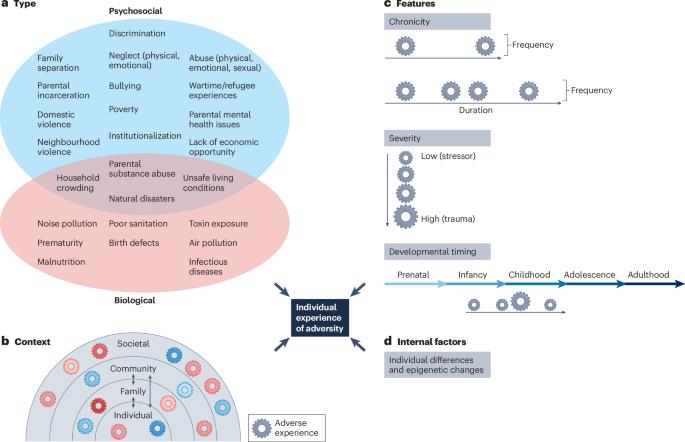Early adversity alters brain architecture and increases susceptibility to mental health disorders
IF 26.7
1区 医学
Q1 NEUROSCIENCES
引用次数: 0
Abstract
Each year, millions of children around the world are exposed to a host of adverse experiences early in life. These include various forms of maltreatment, growing up in unsafe neighbourhoods, and witnessing intimate partner violence. These experiences exact a toll on the brain development and mental health of children. In this Review, we attempt to explain how brain architecture and circuitry are affected by exposure to such early adversity, which in turn increases susceptibility to mental health disorders later in life. We begin defining what we mean by early adversity and then summarize the experience-dependent nature of postnatal brain development. Within this context, we discuss times in development when the brain is particularly receptive to experience (critical periods) and, thus, is more vulnerable to adverse experiences. Drawing from studies with both rodent and non-human primate models and neuroimaging research with humans, we next discuss how the circuitry of the brain is affected by early-life adversity, with a focus on the subsequent effects upon neural network development. We then review the mental health consequences of adverse experiences in early life across mental health disorders and within specific dimensions of psychopathology. We conclude by offering a conceptual model of the pathway that links exposure to adversity early in life to these mental health outcomes later in life, and we provide suggestions for future research. Adverse experiences in early life affect brain development across species. In this Review, Nelson, Sullivan and Valdes discuss neuroimaging evidence for how these adversity-induced changes to human brain architecture alter developmental trajectories that may underpin adult psychopathology.


早期的逆境改变了大脑结构,增加了对精神健康障碍的易感性
每年,世界各地数以百万计的儿童在生命早期就经历了一系列不良经历。其中包括各种形式的虐待、在不安全的社区中长大以及目睹亲密伴侣暴力。这些经历对儿童的大脑发育和心理健康造成了严重影响。在这篇综述中,我们试图解释大脑结构和电路是如何受到早期逆境的影响的,这反过来又增加了以后生活中对精神健康障碍的易感性。我们开始定义早期逆境的含义,然后总结出生后大脑发育依赖经验的本质。在此背景下,我们讨论了大脑特别容易接受经验的发育时期(关键时期),因此更容易受到不良经历的影响。从啮齿类动物和非人类灵长类动物模型的研究以及人类神经影像学研究中,我们接下来讨论了大脑回路如何受到早期生活逆境的影响,重点是对神经网络发展的后续影响。然后,我们回顾了在心理健康障碍和精神病理学的特定维度的早期生活中的不良经历的心理健康后果。最后,我们提供了一个将生命早期逆境暴露与生命后期心理健康结果联系起来的途径的概念模型,并为未来的研究提供了建议。
本文章由计算机程序翻译,如有差异,请以英文原文为准。
求助全文
约1分钟内获得全文
求助全文
来源期刊

Nature Reviews Neuroscience
NEUROSCIENCES-
自引率
0.60%
发文量
104
期刊介绍:
Nature Reviews Neuroscience is a multidisciplinary journal that covers various fields within neuroscience, aiming to offer a comprehensive understanding of the structure and function of the central nervous system. Advances in molecular, developmental, and cognitive neuroscience, facilitated by powerful experimental techniques and theoretical approaches, have made enduring neurobiological questions more accessible. Nature Reviews Neuroscience serves as a reliable and accessible resource, addressing the breadth and depth of modern neuroscience. It acts as an authoritative and engaging reference for scientists interested in all aspects of neuroscience.
 求助内容:
求助内容: 应助结果提醒方式:
应助结果提醒方式:


